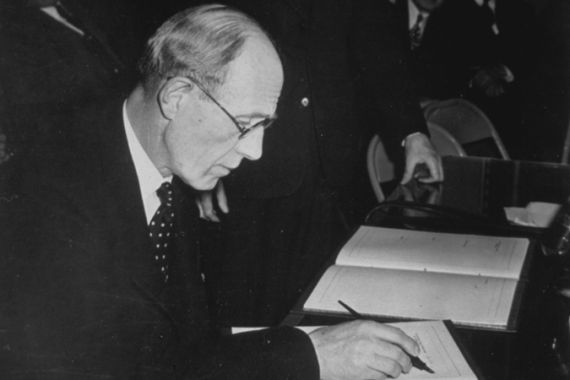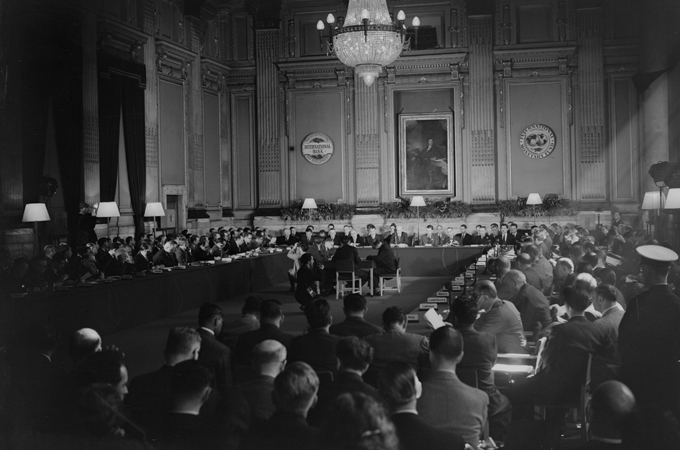
A history of the IMF
A look back at key initiatives established by the International Monetary Fund.
 |
| 1947: The opening meeting of the International Monetary Fund at the Institute of Civil Engineers in London [GALLO/GETTY] |
September 29, 1967 – Board of governors approve plan to establish Special Drawing Rights, or SDRs. An artificial currency unit based upon several national currencies. The Special Drawing Right serves as the official monetary unit of several international organisations including the International Monetary Fund (IMF), and acts as a supplemental reserve for national banking systems. For members of the IMF, the Special Drawing Rights can be used to settle trade balances between countries and to repay the IMF. An IMF member country has to supply its own currency to another member country in exchange for SDRs, unless that country already holds a certain specified amount of SDRs.
October 6-7, 1985 – Interim Committee agrees that about SDR 2.7bn in Trust Fund reflows to become available during 1985 to 1991 will be used to provide concessional lending to low-income members.
Keep reading
list of 4 itemsBiden labels Japan and India ‘xenophobic’ along with China and Russia
KFC Malaysia temporarily closes outlets amid Gaza boycott
Turkey says it halts trade with Israel over Gaza aid access
March 27, 1986 – IMF establishes Structural Adjustment Facility (SAF) to provide balance of payments assistance on concessional terms to low-income developing countries.
December 29, 1987 – IMF establishes Enhanced Structural Adjustment Facility (ESAF) to provide resources to low-income members undertaking strong three-year macroeconomic and structural programmes to improve their balance of payments and foster growth.
August 5, 1992 – IMF approves SDR 719mn Stand-By Arrangement for Russia.
February 1, 1995 – Executive board approves a Stand-By Arrangement of SDR 12.1bn for Mexico, the largest financial commitment by the IMF up until this point.
December 4, 1997 – Executive board approves a Stand-By Arrangement of SDR 15.5bn for Korea, the largest financial commitment in IMF history.
December 17, 1997 – In the wake of the financial crisis in Asia, the IMF establishes the Supplemental Reserve Facility (SRF) to help members cope with sudden and disruptive loss of market confidence. The SRF is activated the next day to support the Stand-By Arrangement for Korea.
April 8, 1998 – Uganda becomes the first member to receive debt relief (approximately $350mn in net-present-value terms) under the HIPC Initiative, to which the IMF is to contribute about $160mn.
2000 – Argentina bailout – “$20bn – $25bn rescue of Argentina that analysts say is the only way to avoid a debt default next year that would reverberate throughout the hemisphere.” “A default on Argentina’s debt could spill over into neighboring Brazil and Chile, wrecking investor confidence in free-market reforms and causing economic chaos.” Much like the situation with Greece. The bailout was considered by many as a short term fix.
January 16, 2002 – IMF Executive Board agrees to a one-year extension of Argentina’s due date for a $933mn repayment under the Supplemental Reserve Facility.
February 4, 2002 – IMF Executive Board approves a three-year $16bn loan for Turkey, the largest one the IMF has extended to date.
January 31, 2005 – The Russian Federation completes the early repayment of its entire outstanding obligations to the IMF amounting to SDR 2.19bn (about $3.33bn). The loans, which had been approved by the IMF Executive Board in March 1996, were originally scheduled to be paid off in 2008.
December 13, 2005 – Brazil announces its intention to make an early repayment of its entire outstanding obligations to the IMF amounting to $15.46bn.
December 15, 2005 – Argentina announces its intention to make an early repayment of its entire outstanding obligations to the IMF amounting to $9.9bn.
October 5, 2006 – Indonesia announces its intention to make an early repayment of its entire outstanding obligations to the IMF amounting to $3.2bn.
By the end of 2007, the IMF had not approved a new large loan, setting aside those loans extended to refinance existing IMF loans, since 2002.
In retrospect, the period of large-scale IMF lending that followed Mexico’s crisis may be viewed as facilitating the transition of many emerging economies from a point where they held too few reserves to navigate periods of financial volatility to a point where most emerging economies held more reserves than they needed.
During the turbulent period between 1995 and 2003, the size of IMF lending was striking. By 2005, though, the size of even the largest IMF loans seemed fairly small relative to the reserves of the typical emerging economies.
For all the criticisms leveled at the IMF, most emerging markets concluded that they needed to hold far more reserves than the IMF was ever willing to make available.